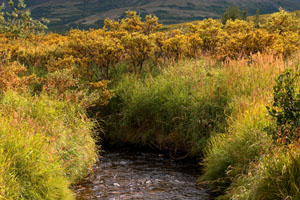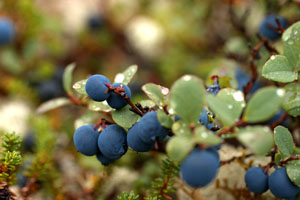|
| |
 Grey skies over the tundra in the tailings lake area. |
I lay in my sleeping bag on a grey August morning, watching raindrops roll down the outside of my tarp. Peering out, I saw the grey pressing down on the dun-colored hills, and dulling the surface of Frying Pan Lake. The landscape looked bleak and uninviting. As I was packing, I heard one of the ubiquitous helicopters roar overhead, reminding me of the controversy surrounding this particular patch of tundra. |
|
The valley where I was camped lies in a remote corner of southwest Alaska; it's unnamed on my maps, and known by almost no one outside the local villages. Yet it may become the site of the largest open pit mine in North America. Underneath the tundra the rocks hold gold, copper, and molybdenum. If permits are granted, the Northern Dynasty mining company plans to dig a pit 2.5 miles wide, and deposit tailings into a toxic lake that would cover more than 20 square miles. |
|
|
This ore deposit sits right at the headwaters of two creeks. The Koktuli feeds into the Nugashak River, a huge waterway which supports Alaska's most prolific run of Chinook salmon. Upper Talarik Creek feeds into Lake Iliamna, the largest lake in Alaska. And the Kvichak River, which drains the lake, is home to the world's largest sockeye salmon fishery.
To get the ore to port, a road would stretch all the way to Cook Inlet, on the Pacific Ocean. From the Bering Sea to the North Pacific, the fingers of this project would reach almost 200 miles. And the potential is even larger. If approved, this would be only one small piece of the enormous Bristol Bay Mining district, which would engulf over 540 square miles of wilderness. |
 Willows and grass line the headwaters of Upper Talarik Creek. |
|
I love the Alaskan wilderness. Over the past five years, I've hiked and paddled over 2000 miles there, in places ranging from Ketchikan to Kaktovik. But I have a special fondness for southwest Alaska. It's some of the most remote and wild country I've visited. The creeks are full of salmon, the windswept tundra is covered with berries, caribou range the hills, and fat brown bears roam everywhere. I couldn't let a great chunk of this wilderness be destroyed without at least seeing it for myself. And I hoped, in traveling to the proposed Pebble Mine site, that I could bring back beautiful photos to inspire others to save it from destruction. |
|
|
But first, I needed the beautiful photos. I stepped out into the drizzle, armed with eight pounds of camera gear. Under the socked-in sky, the landscape was stark, bleak, and dreary. But the berries were ripe, and the plants were turning colors with the fall. I knelt down to grab a handful of blueberries and reached for my macro lens. The labrador tea smelled stronger than ever with my nose so close to the ground, and crushed blueberries stained my knees purple. The lingonberries and bog cranberries looked tasty, but their bright red tops are deceptive; they wouldn't be ripe for another month. The crowberries were abundant, but didn't seem worth it, and I wasn't nearly hungry enough to nibble on the reindeer moss. This ubiquitous lichen is the primary food source for caribou, but it's only last-ditch survival fare for humans. |
 A luscious crop of blueberries coats the tundra. |
 Red foliage and bog cranberries poke up from a thick mat of sphagnum moss. |
|
|
Judging by the proliferation of deep narrow trails and discarded antlers, caribou had often spent time in this valley. I'd seen both caribou and bears on my way out here, but I saw none now. As another helicopter thundered past, I could see why this valley had been abandoned by its usual residents. Despite my understanding that the helicopters weren't out to get me, I still wanted to run and hide every time one roared over. If I were a caribou, I'd be long gone. As I walked into the rolling flats of the proposed tailings lake, the wind and rain picked up, whipping the tiny plants into photographic blurs, and spattering water across my lens. But I could see that the landscape had been sculpted by much greater storms. The wind here streams across the flats and scours the hilltops, punishing anything that sticks up too high. The plants hug the ground in a close-knit mat, surviving by being low and crowded. Gullies provide the only windbreaks, and grass and bushes grow tall and green in their depths. The caribou trails avoided these brushy tangles whenever possible, and I followed their lead. In the afternoon, the wind slacked off, and it was quiet on the grey tundra. Then a soft buzzing appeared. It quickly grew stronger, and the tiny insects responsible for it soon formed a persistent cloud around my head. The wind of only a few hours earlier now seemed like an incredible luxury. |
|
|
By evening, the wind returned, and I set up my tarp in the lee of a waist-high boulder. I bent my mind back to the strange reason I had come to this wilderness. I'd just spent the whole day hiking in what could become a giant tailings lake. How could everything around me - literally everything I could see, and everything I walked through all day, disappear into a toxic muck pond? Standing alone in the middle of it, I found it hard to believe. The next day I circled back towards the heart of the proposed mine, following a series of low ridges. Off to my right, the helicopters roared almost constantly over the valley floor, engaged in their mysterious mining surveys. |
|
 The reflections on Frying Pan Lake shine in a rare flash of sun. |
|
|
Now well into the ore deposit, I carefully scanned the rocks at my feet. I expected them to look different; special somehow. But to my eye, they were all quite ordinary. Without all this activity, this spot would look no different than the rest of the tundra. And really, it is no different than the rest of the tundra. The land I passed through on my way to the mine site was dotted with claim stakes. Pebble Mine, as large as it might be, would be only one small piece of the enormous Bristol Bay Mining district. All of this land is at risk. |
|
 A caribou stands in the smoke haze, just outside the Pebble Mine area. |
I set up my tarp on the hill overlooking the valley, and crawled out the next morning into one of the strangest sunny days I've seen. The sun hung overhead as a red-tinged orb. The valley below had completely disappeared. A strong breeze blew from the northwest, and the world was engulfed by a thick, dry fog of smoke from some distant forest fire. I began the trek back to Nondalton. I had gone out to photograph this unknown spot at the heart of a controversy, hoping to get it noticed. Now more than ever, I wanted to save this wilderness. But other than an occasional flash of sun, I wasn't going to get my beautiful landscape weather. How could I explain my passion for this land to anyone else? |
|
In its subtle way, the tundra is beautiful. But it has no awesome glaciers, craggy peaks, or giant trees. Tourists don't often buy postcards of tundra. Pebble Mine would not destroy the most beautiful place on earth, but it would destroy something just as rare. Wilderness is a thing so besieged in our world that most can no longer even grasp what it is. In this wilderness, birds feed in the wetlands, bears crowd the banks of salmon-rich streams, and caribou roam the hillsides. The rolling tundra seems to stretch on forever, without roads, dams, or fences. The land is unscarred and unpoisoned. |
 The sun sets in a pink haze of forest fire smoke. |
|
Large open pit mines can be seen from earth's orbit with the naked eye. From this ridge a few miles away, the scar would be so large that I couldn't even see it all. The hard rock mining industry creates more toxic pollution than any other industry in the country. Any toxins left behind would remain through the millennia, until the glaciers of the next ice age pushed them into the Bering Sea. The gold under the tundra may last for a few decades. The wilderness will be gone forever. Erin McKittrick - November 2005 |
|
Read the guestbook | Sign the guestbook
All content by Erin McKittrick, copyright 2006-2007. Contact me with comments or questions at mckittre at gmail dot com.
Go to Alaska Trekking home. Go to Ground Truth Trekking home.
Last modified: 2/11/2007